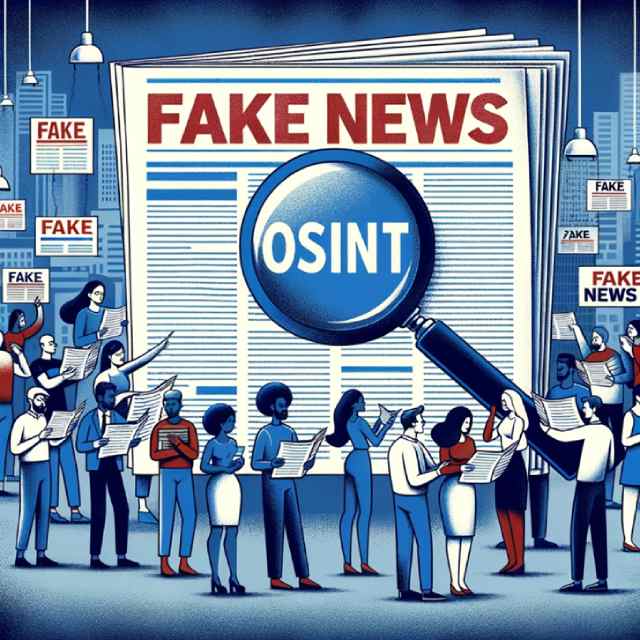OSINT: an underused weapon for journalism to combat fake news
We published an article about the threat of deepfakes back in October. Today we will talk about something related to fake news and how they are related and what differences exist between the two concepts.
We will comment on the main weapon, in my point of view, that the media must minimize the risk of being part (involuntarily) in disinformation campaigns.
We will also reflect on the reasons why this weapon is currently underused in the most relevant media and some conclusions about the current scenario and possible points for improvement.
Fake news
The term fake news refers to the deliberate dissemination of false or misleading information for political, economic or social purposes.
Fake news seeks to manipulate public opinion, generate confusion or distrust, and erode the credibility of truthful sources of information. They are usually distributed through social networks, blogs, websites, messaging applications or related media.
 AI image
AI image
How is fake news related to deep fakes?
One of the most sophisticated and dangerous techniques to create and spread fake news is the use of deep fakes, which consist of videos or audios altered by artificial intelligence, which make a person appear to say or do something that he or she has not said or done.
Deep fakes would be something like the Champions League of techniques to generate fake news.
There are much more mundane and massive methods for their generation, such as the simple manipulation of images or the dissemination of hoaxes. But let's move on to the most interesting question: How to combat fake news?
OSINT (Open Source Intelligence)
One of the ways to detect and combat fake news is by using the OSINT (Open-Source Intelligence) technique, which consists of analyzing information from open and public sources.
OSINT is a technique widely used in the cyber world, for example, in reconnaissance campaigns by attackers or threat intelligence by defense teams. It makes it possible to contrast, verify and trace the provenance of information, as well as to identify possible biases, manipulations, or distortions.
This technique, however, requires research skills and is usually supported by the use of digital tools with a certain degree of specialization such as search engines, meta-search engines, reverse image or video search engines, databases or maps.
Current situation in the media
The mass media have a key role to play in the fight against fake news, as they are the main source of trusted information for citizens. They are a kind of last bastion where we can check whether the incredibly controversial information that has reached us through social networks is true or not.
If that trust is lost, the impact on the average citizen would be brutal, the barrier between truth and lies would become practically indecipherable.
But the devilish pace of news generation is putting to the test the traditional processes of these media, which are based on trusted sources of information, something that today seems insufficient or at least limited.
The problems of this situation become more palpable in turbulent times like the present. An enormous amount of information of various kinds: videos, photographs, satellite images, maps, etc. reaches the editorial offices of the main media currently.
This is where the internal struggle begins, in each media outlet, between being the first to provide relevant news and, on the other hand, contrasting the veracity of the information in detail.
As John Burn-Murdoch, chief data reporter at the Financial Times, describes magnificently in a thread that served as inspiration for this post and which we highly recommend reading.
The media are not prepared for semi-automatic information processing, few have teams specialized in OSINT techniques, and in the few that do, these teams rarely have the credibility and internal weight necessary to stop the machines on a news story of international relevance.
Conclusions
Fake news is a complex and dynamic phenomenon, for which the media must adapt their information verification processes and probably incorporate new capabilities such as the creation of specialized information verification teams.
This need will become more and more evident and pressing as the generation of deep fakes becomes more economical and therefore, their use intensifies.
The media can outsource this capability to a trusted third party while this internal capability is being achieved. This third party should be part of the processes as another source of information, like their traditional internal contacts, and should serve to verify, at least initially, the credibility of a given piece of information.
And it is important to emphasize: a third party of trust. Here trust is the crucial element, as much or more than that of the certification authorities for SSL/TLS certificates, much of the trust of its users depends on it.
We believe that the outsourcing option will be more common in media with fewer resources, but for those large media, for which trust, and credibility is of vital importance, basically, their main reason for existence in today's hyper-connected world. The future will be for specialized in-house teams with OSINT capabilities to mitigate the effects of the fake news phenomenon that, unfortunately, is here to stay.
Image from Freepik.
 Hybrid Cloud
Hybrid Cloud Cyber Security & NaaS
Cyber Security & NaaS AI & Data
AI & Data IoT & Connectivity
IoT & Connectivity Business Applications
Business Applications Intelligent Workplace
Intelligent Workplace Consulting & Professional Services
Consulting & Professional Services Small Medium Enterprise
Small Medium Enterprise Health and Social Care
Health and Social Care Industry
Industry Retail
Retail Tourism and Leisure
Tourism and Leisure Transport & Logistics
Transport & Logistics Energy & Utilities
Energy & Utilities Banking and Finance
Banking and Finance Sports
Sports Smart Cities
Smart Cities.jpg)





